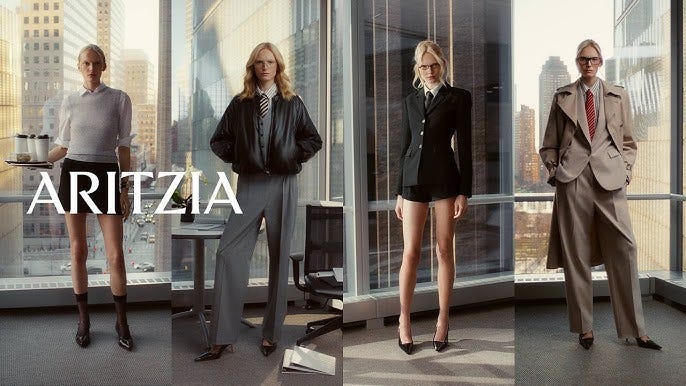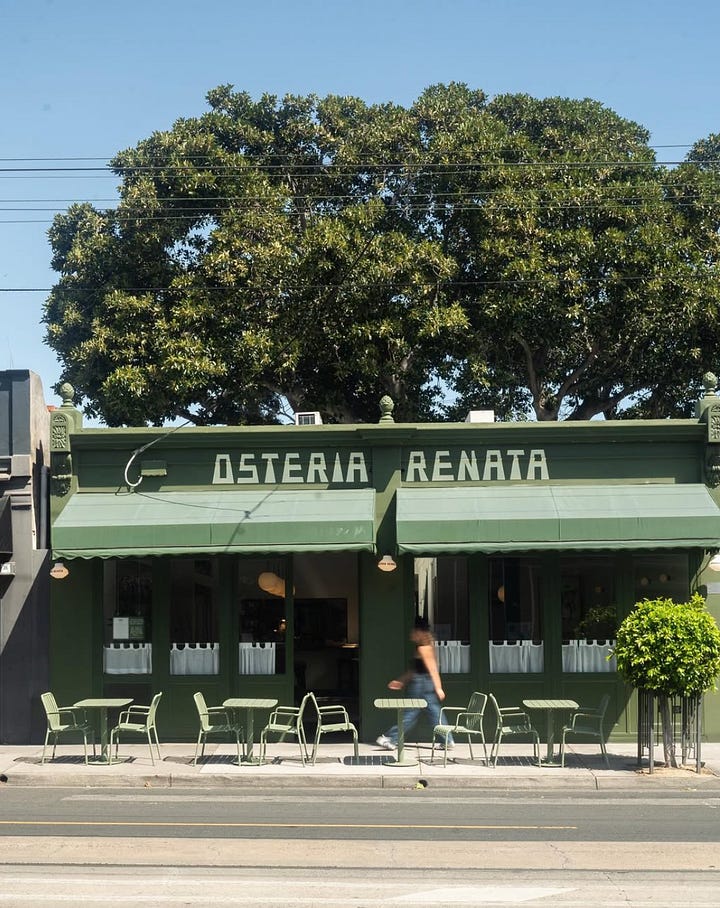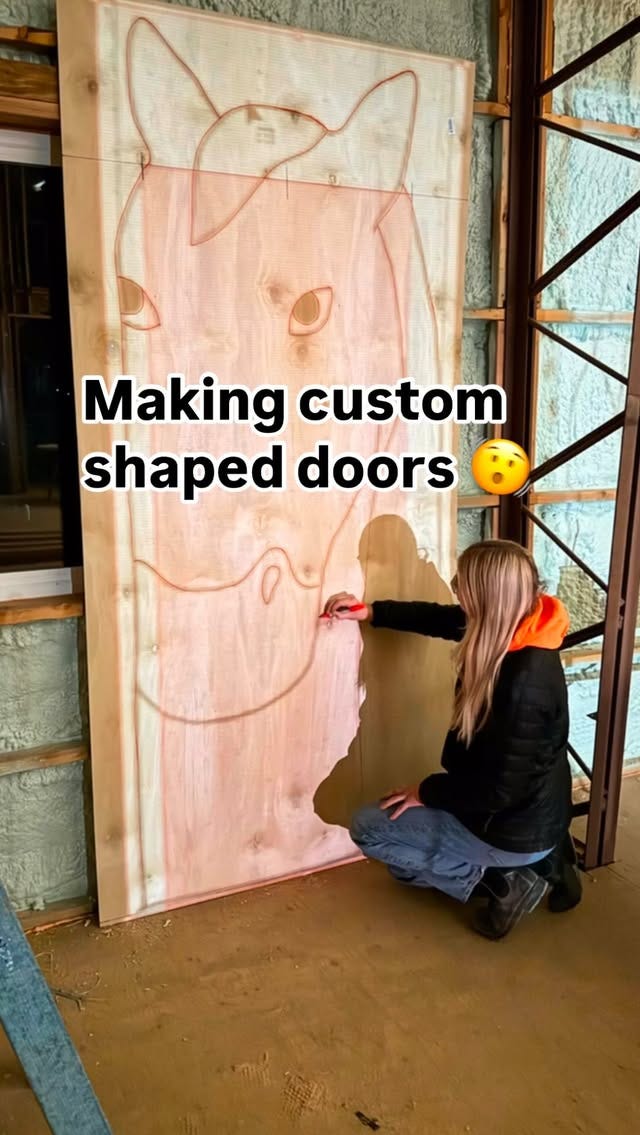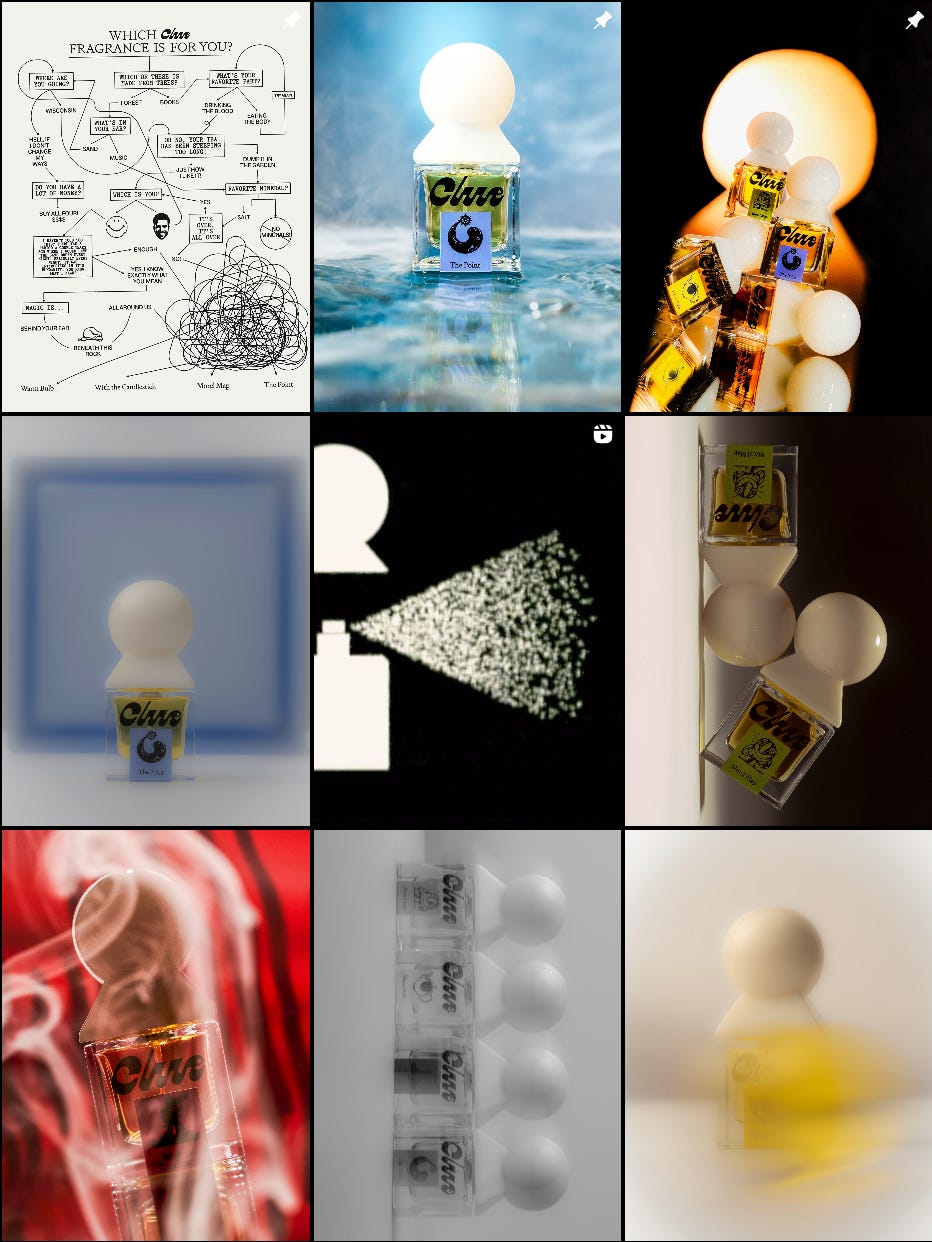I don't need another sale, I need a reason to care
plus, five inspiring brand visuals (that aren't from the usual DTC darlings)
Is your brand fine-but-forgettable? Dare I say, mid?
Hey, brand nerds! 👋
Scrolling through my saved links this week—articles about economic anxiety, the boom boom aesthetic, existential creative crises, and our desperate search for genuine connection—I realized they were all orbiting the same change in consumer psychology: as economic uncertainty rises, the more we search for meaning and inspiration in the things we consume and experience.
I don’t know about you, but beyond groceries and necessities, I've become increasingly ruthless and selective about where my money goes. If I'm going to part with my limited dollars, it better create an actual moment of joy or meaning, not just another thing to own.
Less "Can I squeeze this into my budget?" and more "Will owning/buying/using this actually make me feel something worth feeling?" Less "this was 40% off" and more "this makes me feel 40% more alive."
It's a specific kind of doom-splurging: instead of rationalizing to myself that I'm being "smart" about a purchase, I'm admitting I'm being emotional about it—I want it to make me FEEL GOOD.
In today's newsletter:
Link roundup: required reading from the past week
What this can mean for brands—a few notes on strategy
Five creative sources of inspiration—from brands outside of the usual buzzy DTC darlings that Substackers love writing about (IYKYK)
Links I Saved This Week:
Breadcrumbs to Consumer Culture
I took a deliberate step back from the Substack echo chamber last week. Too many brand newsletters circulate the same ten articles about Brand A's latest misstep or Brand B's new content series, etc etc. The algorithmic regurgitation (and each writer just nicking links off each other) is becoming a rat race with increasingly diminishing returns on insight.
So instead, I challenged myself to look for signals that aren't necessarily buzzy or "breaking news" but reveal something deeper about where consumer culture is heading.
Things Are Bleak: The Economic Reality
Are you doom-prepping or doom-splurging?—This Morning Brew report and CreditCards.com survey reveal similar things: Americans across all income levels are cutting back on necessities. People are broke, or feeling broke. In light of recent tariff skirmishes, 1 in 5 Americans classify their recent behavior as "doom-spending." In this environment, the emotional stakes of discretionary purchases skyrocket. When grocery prices are knee-bucklingly off-the-charts, anything beyond necessities damn well better deliver a big emotional payoff.

I don't know if I want to participate in the "boom boom aesthetic"—The new cultural phrase that's picking up steam? The "boom boom" aesthetic. Coined by Sean Monahan (who also coined "normcore" and "vibe shift"), it refers to this cultural trend towards 80s excess, bling, champagne and caviar, power suits, and conspicuous, look-at-me wealth. I'm sure some will try to liken it to a Mad Men aesthetic, but the subtext feels kinda Trumpcore to me. (Also, see: “The conservative creep of the internet.”) What I will say though, is that I'm personally bored to tears with quiet luxury's basic, beige minimalism, so I'm glad that we're now looking to swing the pendulum away from that. But what I actually want—and suspect many others do too—is just more goddamn personality in my stuff. I want color and weirdness and imperfection. I want things that feel like art, things that feel touched by human hands. Do you find yourself wanting that, too?

"The ultimate luxury is a steady paycheck"—Alyssa Vingan's piece "How to Dress for the Job You Want, but No Longer Exists" expounds on the boom boom aesthetic, through a fashion lens. She juxtaposes the trend with this economic moment when stable employment feels increasingly out of reach. There's a dark throughline between what fashion is selling (excess, greed, corpcore) and what people actually crave (basic security, a steady paycheck). As she perfectly puts it:
"This trend centers wealth of the not stealth sort (RIP quiet luxury), but for those of us navigating the current job market, financial security feels more out of reach than ever… When stability is the ultimate luxury, you know that things are bleak."
We Crave More Meaningful Careers & Connections
The creative professional's existential crisis—Designer Aureliea Deaz's talk featured a slide that gained lots of traction on Instagram, as it reads: "How to make the logo bigger when the world is burning?" This perfectly captures the weird feeling of working in creative fields, peddling products no one really needs, all while Rome burns all around us. The cognitive dissonance is growing increasingly hard to ignore. I'm curious about what this sentiment can bring out in creative professionals in the next few years.
Instagram Close Friends still makes me feel like I'm creating content—Kate Lindsay put Letterloop on my radar this week – think of it as a friends-only newsletter where sharing feels like connection, not content creation. You pick your people, then pick questions to send for the month (i.e. "What's something you're really into right now?" or "What's the best purchase you recently made?") and everyone has one week to respond. Letterloop then aggregates all answers into a single email. Everyone then gets a lovely, analog-feeling digest of your friends' inner lives. I love this because personally, I used to use the internet as a way to share my life with like-hearted friends. But as it increasingly grew into a marketplace and entertainment feed, the personal sharing part became relegated to Instagram Stories Close Friends. But even that feels like broadcasting without interpersonal context or meaningful exchange—it still feels likes content creation, ultimately.
We Crave Creativity & Uniqueness
Risk aversion is killing us—Beth Bentley argues that we’re in an era of paralyzing risk aversion, resulting in a boring landscape where brands look and sound identical. Our obsession with being "data-driven" has backfired spectacularly. When everyone has access to the same performance metrics and "best practices," we end up with a creative arms race to the middle. The result? Templated everything. Mimetic branding and marketing. An over-indexing of "what works", and a death of originality and inspiring craft.
Doors don't have to be rectangles—Artist Lorien Stern's custom animal-shaped doors struck me as the perfect metaphor for what we're craving: breaking out of templates, if mostly just for the f*cking fun of it. This is what I want to see more of on my feed!
If You Want My Limited Dollars, You Better INSPIRE Me
Of course, the basic psychology of marketing and discounts still holds. But over-indexing on volume—whether it's discounts, content, or ad spend—won't tide brands over in this economic moment.
Two realities colliding that are unique to this moment:
Those of us who came of age alongside e-commerce have absorbed brand strategy through sheer, relentless exposure. Generation Alpha, Gen Z, and millennials possess unprecedented fluency in brand strategy and marketing tactics. We recognize the "hook" in TikTok videos before the creator even speaks. We can identify a templated Meta ad carousel at first glance. And so…
Diminishing returns have set in. The DTC playbook that felt revolutionary in 2015—new-school back then—has become old-school. Limited-time offers, countdown timers, and artificial scarcity just blend into the background noise of our inboxes. It's not even that we're annoyed (we don't unsubscribe, after all)—we're just growing increasingly indifferent, because, what do you know? There'll be another sale next month anyway.
Brands are white-knuckling their way through uncertainty by blasting more ads (scroll through Instagram and try to differentiate between DTC brands in the same category without looking at their names), publishing more posts, sending more emails.
But think about the consumer psyche in today’s economy: what if you risk numbing your audience, where you can be inspiring them?
As economic pressure intensifies through 2025, I predict consumer behavior will bifurcate further: increasingly practical about necessities, while demanding more meaning and emotional connection for everything else.
In this new landscape, the middle is not the place you want to be. (As Gen Z would say, just don’t be mid.) The last thing you want to be is fine-but-forgettable.
If sales are sliding and your brand’s isn't resonating like it used to, here's what to consider in 2025:
Audit your content balance - Take a hard look at your marketing mix. Most brands are massively over-indexing on performance tactics while treating inspiration as an afterthought. Those endless carousel ads explaining product features might be optimized for algorithms, but they're not breaking through consumer indifference. Modern brands need both—practical information and genuine inspiration.
Read the damn room - Smart brands will double-down on understanding their core customer to know where and when to push inspiration vs. information. Again, brands in 2025 must do both, it’s all about context and timing.
Recalibrate your expectations for ROAS - This isn't 2015's DTC heyday anymore. The consumer funnel isn't as linear as it was: today's path to purchase includes numerous "holding patterns"—Pinterest boards, TikTok saved collections, screenshot folders—where potential purchases live sometimes for months before conversion. Smart brands are creating content worth saving and revisiting rather than forcing immediate transactions. Obsessing solely over immediate ROAS is increasingly short-sighted, potentially becoming the difference between building a brand with cultural staying power versus one grasping for an exit strategy.
My proposal? Shave 20% off your Meta ads budget and allocate it to a creative risk.
In an era where product features can be duplicated overnight and pricing undercut tomorrow, your most defensible asset is a distinctive perspective and a bold stance. Create something that actually participates in actual cultural conversation.
After all, insanity is doing the same thing over and over again—i.e. continually paying Meta thousands and thousands of dollars—and expecting different results.
5 Inspiring Brand Examples That Break the Mold
Let's take a break from the usual suspects. I've collected five brands that are quietly doing their own thing—focused on delighting their specific core audience rather than chasing universal appeal.
Add these to your inspiration folder:
1. Clue Perfumery (Chicago)
This niche fragrance house skips the Tiktok tactics—very refreshing. Instead, their feed feels like a creative director's private mood board: clever artistic references and atmospheric imagery, with barely a sales pitch in sight.
But the brilliant thing is, if you do a little bit of social listening, you can see that they have tons of perfume enthusiasts and frag-fluencers posting unboxing and review videos of their product so they don't have to.
Their owned feed = aspiration and inspiration; creator-generated content = information dissemination. Not sure if that was intentional strategy, but I like it.
2. Osteria Renata (Australia)
Their approach to short videos reminds me of early blogosphere aesthetics—beautifully crafted films (uploaded on Vimeo!) with artful typography and creative editing. In an era of algorithm-optimized content, their films stand out precisely because it doesn't feel engineered for immediate conversion or max engagement.
It does such a great job of conveying an aspirational experience and vibe you’d wand to be around. Like, if I were cutting down my eating-out expenses, I'd like my one precious date night for the month to feel this special and high-end, so this restaurant will be high on my list.




3. SuperStudio (Canada)
Their viral video (8M views!) showcasing the creative process behind their work on Rose Boulangerie's identity brings much-needed tactility back to design.
Watching human hands manipulate physical materials feels revolutionary in our increasingly digital landscape. It's a reminder that showing the messy, beautiful process can be more compelling than just the polished final product.
The opportunities I see for brands: Get more tactile and sensory. Step away from flat, catalog-like images, even just for a moment. Collaborate with an analog or mixed media artist (see next example for another take) and deliberately show human hands making things, especially as more and more AI is becoming the norm.
4. Saint's Production + Yardstick Coffee (Manila, Philippines)
Manila - my hometown! - is home to SO much amazing talent. Case in point: Saint's Production's work for Yardstick Coffee (see above). Instead of the basic counter display, they commissioned him to create atmospheric video backdrops for their barista station.
Most budget-conscious owners would axe this as an unnecessary expense, but Yardstick gets it—their café is a creative hub where the city's designers and artists congregate daily. The takeaway? Know your core customers so well that you can make bold creative choices that would resonate deeply with them.
And like the Rose Boulangerie example above, BTS content is key—there's something powerfully engaging about seeing the human hands and creative process behind these projects. (Here’s another dope behind-the-scenes video from Saint’s work with Nike.)
5. Orca Living (California)
A Pinterest ad for Orca’s permeable pavers (yes, really) stopped my scroll, but what converted me into a follower wasn't the product—it was their breathtaking, artful photography and videography that makes you want to immediately reimagine your entire outdoor space.
Their playbook is perfect for high-consideration purchases (things with longer decision timelines, higher price points, and multiple stakeholders—like any big home-related items): use targeted performance marketing as the hook, then serve up deeply inspiring content that keeps you in their orbit during the months you're researching and comparing options. By the time you're ready to buy, you've been marinating in their aesthetic vision so long that you can't imagine going elsewhere.
I hope this week’s newsletter gave you lots to think about—not just in your creative work, but in thinking about how we participate in (and shape) consumer culture as a whole.
Until next time,
Arriane
P.S. As always, feel free to send me more examples of what’s inspiring you this week—I might include them in the next roundup and credit you ;-)

















you got me at creative director's private mood board ;D
I APPRECIATE YOUR FRESH PERSPECTIVE AND WILLINGNESS TO STRAY FROM THE STATUS QUO 🪽